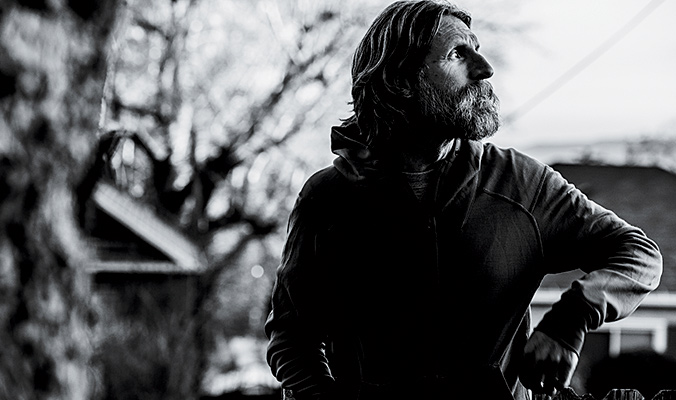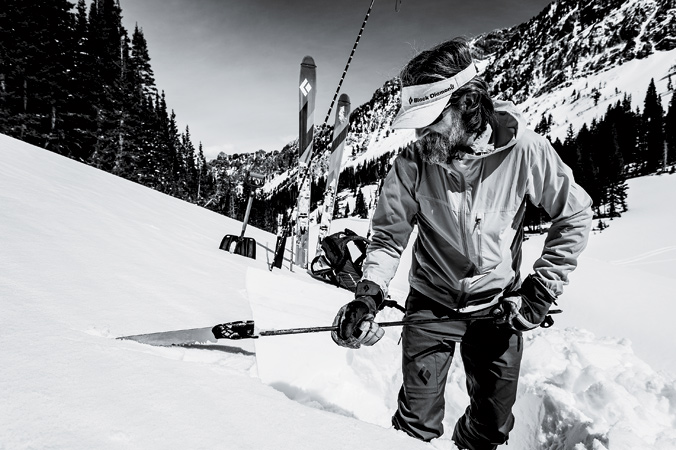Knowledge is power and, in the mountains, it leads to powder. But getting there and doing it safely takes time, practice and lessons both formal and not. And this year’s Skills Guide is a platform from which to dip a toe into the off piste, the impetus to dive headlong into a backcountry education or an opportunity to refresh and rethink personal processes. Because no matter your background, there’s always more to learn. And, just like traveling through the mountains, there’s pleasure in the pursuit.
—
Drew Hardesty is a long-time forecaster with the Utah Avalanche Center and climbing ranger in Grand Teton National Park. Here, he muses on how setting the right goals and intentions for the day will help define safety parameters for any objective.

Drew Hardesty contemplates Buddhism, groupthink and how much avocado to include on his turkey sandwich. [Photo] Mattias Fredriksson
On Learning
Years ago, I was skiing with a wife of an old mentor of mine—the danger that day was considerable. We had no intention of skiing anything crazy; we were just working ridgelines. We were on Gobbler’s Knob above a ridge, and I had ripped my skins, but my partner had not fully transitioned. So I figured I would work my way down the ridge to get a head start and check things out. I had to work through some wind whales and trees, so I thought that if I ducked off the ridge, I could avoid the nuisance. As I dropped down onto the 22-degree slope, I heard the thunderclap—I had collapsed the hard slab onto the facets below, and I was at the top of an avalanche three to five feet deep and 500 feet wide. I knew the avalanche was unwitnessed, because my partner was still at the top. So I started swimming over to a tree—I knew I couldn’t be buried. I was ripped off that tree and grabbed another tree and was ripped off again, but by that time the avalanche had slowed to the point where I was left on top. There’s an old joke: “The only way to make God laugh is to appraise him of your plans.” Never underestimate the propagation potential of a hard slab over faceted snow. Don’t be lazy with communication, and remember that you have a partner for a reason.

Utah Avalanche Center forecaster Drew Hardesty cuts to the chase. [Photo] Mattias Fredriksson
On Risk
Risk is related to whom you are skiing for. Are you skiing for yourself or are you skiing with your friends and family in mind? You need to understand how your decisions affect the community at large. Then there’s the added level of when I’m on the clock. If that’s the case, I’m skiing for the government and my job, and I need to make more conservative decisions.
On Turning Around
Noah Howell has a great perspective, and I’ll paraphrase: “We all have the same goal, and that’s to get back to the truck at the end of the day.” In terms of decision making, if you start with a foundation of uncertainties and build on top of that with other variables, you need to be clear about how shaky that foundation is [in order to] judge when your objective is no longer a good idea.
On Trip Prep
This is predicated on the Buddhist idea of the Noble Eightfold Path. You have to have the right objective at the right time with the right weather, the right avalanche conditions, the right partner and the right mindset. All of these things need to come together for planning a trip.
On Skills
I think really important skills to have are honesty and backbone, because we all suffer from varying degrees of ego. There are pitfalls like groupthink and disagreeing with the forecast or not wanting to hold the group up. But you have to be your own person, speak your mind and have the honesty and backbone to say, “You guys think the snowpack looks like this, but I think it looks like that.”
On Snacks
I’m all about the turkey-avocado sandwich and water. I like baked goods, but I can’t bake to save my life.
—










Yawn. Another Tennessee mt. avi expert. Ugh